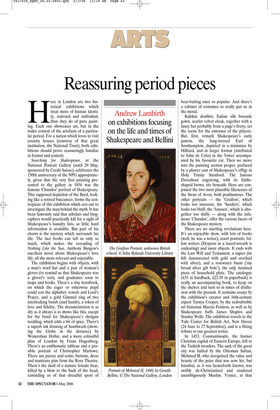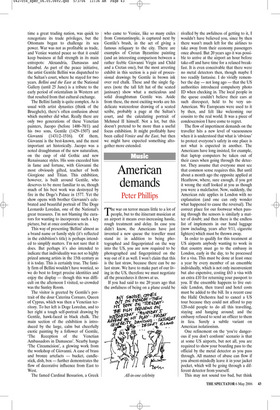Reassuring period pieces
Andrew Lambirth on exhibitions focusing on the life and times of Shakespeare and Bellini
Here in London are two historical exhibitions which treat more of human identity, national and individual, than they do of pure painting. Each one showcases art, but in the wider context of the artefacts of a particular period. For a nation which loves to visit country houses (courtesy of that great institution, the National Trust), both exhibitions should prove reassuringly familiar in format and content.
Searching for Shakespeare, at the National Portrait Gallery (until 29 May, sponsored by Credit Suisse), celebrates the 150th anniversary of the NPG appropriately, given that the very first painting presented to the gallery in 1856 was the famous ‘Chandos’ portrait of Shakespeare. This supposed depiction of the Bard, looking like a retired buccaneer, forms the centrepiece of this exhibition which sets out to investigate the man behind the myth. It has been famously said that scholars and biographers would practically kill for a sight of Shakespeare’s laundry lists, so little hard information is available. But part of his charm is the mystery which surrounds his life. The fact books can tell us only so much, which makes the rereading of Nothing Like the Sun, Anthony Burgess’s excellent novel about Shakespeare’s love life, all the more relevant and enjoyable.
The exhibition begins with objects, with a man’s wool hat and a pair of woman’s gloves (to remind us that Shakespeare was a glover’s son), and graduates soon to maps and books. There’s a tiny hornbook, on which the eager or otherwise pupil could con the alphabet, vowels and Lord’s Prayer, and a gold Gimmel ring of two interlocking bands (and hands), a token of love and fidelity. The documentation is as dry as it always is in shows like this, except for the bond for Shakespeare’s shotgun wedding, which adds a bit of spice. There’s a superb ink drawing of Southwark (showing the Globe in the distance) by Wenceslaus Hollar, and a more colourful plan of London by Frans Hogenberg. There’s an emblematic tableau and a possible portrait of Christopher Marlowe. There are purses and coins, buttons, dress and manicure pins from the Rose Theatre. There’s the skull of a mature female bear, killed by a blow to the back of the head, reminding us of that dreadful sport of bear-baiting once so popular. And there’s a cabinet of costumes to really put us in the mood.
Kidskin doublet, Italian silk brocade gown, scarlet velvet cloak, together with a fancy hat probably from a page’s livery, set the scene for the entrance of the players. But, first, remark Shakespeare’s early patron, the long-tressed Earl of Southampton, depicted in a miniature by Hilliard, and in larger format (attributed to John de Critz) in the Tower accompanied by his favourite cat. Then we move into the painting section proper, prefaced by a plaster cast of Shakespeare’s effigy in Holy Trinity Stratford. The famous Droeshout engraving, with its fiddleshaped brows, sits beneath. Here are conjoined the two most plausible likenesses of the Swan of Avon, both posthumous. The other portraits — the ‘Grafton’, which looks too innocent, the ‘Sanders’, which looks too bluff, the ‘Janssen’, which is altogether too shifty — along with the infamous ‘Chandos’, offer the various facets of the Shakespeare mystery.
There are no startling revelations here. It’s an enjoyable show, with lots of books (well, he was a writer), court portraits, fellow writers (Drayton in a laurel-wreath is endearing) and more objects. It ends with the Last Will and Testament, a rapier (its hilt damascened with gold and overlaid with silver), and a rosewater basin (‘my broad silver gilt bole’), the only itemised piece of household plate. The catalogue (£35 in hardback, £22.50 in paperback) is really an accompanying book, to keep on the shelves and turn to in times of disillusion with the present. It contains essays by the exhibition’s curator and 16th-century expert Tarnya Cooper, by the redoubtable art historian Marcia Pointon, as well as by Shakespeare buffs James Shapiro and Stanley Wells. The exhibition travels to the Yale Center for British Art, New Haven (24 June to 27 September), and is a fitting tribute to our greatest writer.
In 1453, Constantinople, the former Christian capital of Eastern Europe, fell to the Turkish invaders. The sack of the great city was halted by the Ottoman Sultan, Mehmed II, who recognised the value and beauty of the prize that was now his, but Istanbul, as it was henceforth known, was swiftly de-Christianised and rendered unambiguously Muslim. Venice, at that time a great trading nation, was quick to renegotiate its trade privileges, but the Ottomans began to challenge its sea power. War was not as profitable as trade, and Venice wanted peace so that it could keep business at full strength in its main entrepots: Alexandria, Damascus and Istanbul. As part of the peace initiative, the artist Gentile Bellini was dispatched to the Sultan’s court, where he stayed for two years. Bellini and the East at the National Gallery (until 25 June) is a tribute to the early period of orientalism in Western art that resulted from that cultural exchange.
The Bellini family is quite complex. As is usual with artist dynasties (think of the Brueghels), there’s often confusion about which member did what. Really there are only two generations of these Venetian painters, Jacopo (before 1400–70/1) and his two sons, Gentile (1429–1507) and Giovanni (1431/2–1516). Of them, Giovanni is the best-known, and the most important art historically. Jacopo was a noted draughtsman of the new naturalism, on the cusp of old Gothic and new Renaissance styles. His sons exceeded him in fame and fortune, with Giovanni the most obviously gifted, teacher of both Giorgione and Titian. This exhibition, however, is built around Gentile, who deserves to be more familiar to us, though much of his best work was destroyed by fire in the Doge’s Palace in 1577. Yet the show opens with brother Giovanni’s celebrated and beautiful portrait of The Doge Leonardo Loredan, one of the National’s great treasures. I’m not blaming the curators for wanting to incorporate such a key picture, but at once confusion sets in.
This way of presenting ‘Bellini’ almost as a brand name or family style (it’s reflected in the exhibition’s title) is perhaps intended to simplify matters. I’m not sure that it does. But perhaps it’s also intended to indicate that individuality was not so highly prized among artists in the 15th century as it is today. This is certainly true. The family firm of Bellini wouldn’t have worried, so we do best to forget precise identities and enjoy the display — though this was difficult on the afternoon I visited, so crowded was the Sunley Room.
The visitor is greeted by Gentile’s portrait of the dour Caterina Cornaro, Queen of Cyprus, which was then a Venetian territory. To her left is Doge Loredan, and to her right a tough self-portrait drawing by Gentile, hawk-faced in black chalk. The main section of the exhibition is introduced by the large, calm but cheerfully exotic painting by a follower of Gentile, ‘The Reception of the Venetian Ambassadors in Damascus’. Nearby hangs ‘The Circumcision’, a glowing work from the workshop of Giovanni. A case of brass and bronze artefacts — bucket, candlestick, dish, box — further demonstrates the flow of decorative influence from East to West.
The famed Cardinal Bessarion, a Greek who came to Venice, like so many exiles from Constantinople, is captured next by Gentile’s brush, in the act of giving a famous reliquary to the city. There are examples of Cretan Byzantine painting (and an interesting comparison between a rather feeble Giovanni Virgin and Child and a Cretan one), but the most arresting exhibit in this section is a pair of processional drawings by Gentile in brown ink over red chalk. These and the single figures (note the tall felt hat of the seated janissary) show what a meticulous and solid draughtsman Gentile was. Aside from these, the most exciting works are his delicate watercolour drawing of a seated scribe, probably a page at the Sultan’s court, and the calculating portrait of Mehmed II himself. Not a lot, but this doesn’t pretend to be more than a useful focus exhibition. It might profitably have been called Venice and the East, but then we might have expected something altogether more extended.















































 Previous page
Previous page